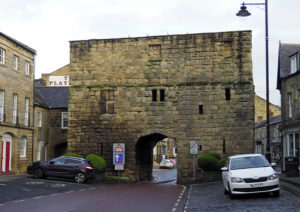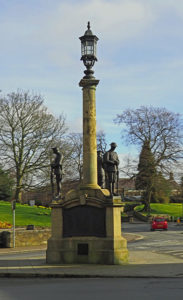Alnwick is a Saxon place name with wik meaning dairy farm. A settlement grew up beside a ford on the River Aln on the main north south route through Northumberland.
The town grew up in the shelter of the Castle, which dominates the west side of the town. The classic view of the castle is from the Lion Bridge with its cast iron Percy Lion in the centre of the parapet.
After the Norman Conquest land was granted to Gilbert de Tesson who built a motte and bailey castle here, guarding the crossing point of the river. De Tesson was stripped of his land after taking place in an abortive uprising against William II and his estates were granted to Ivo de Vesci who became 1st Baron of Alnwick. He was responsible for building a stone castle here. When the last de Vesci died without an heir, the barony was bought by Lord Henry Percy, and is still belongs to the Percy family today. He was responsible for making the castle a mighty border fortress.
By the C17th the Percy family were no longer living in the castle and it was damaged in the Civil War. The First Duke of Northumberland began a massive restoration programme in the 1700s, employing Robert Adam turning the medieval fortress into the more comfortable Gothic style building. In the mid C19th, the Fourth Duke employed Anthony Salvin to restore a more authentic medieval border fortress to the outside with sturdy stone walls and towers. Stone figures were added to the battlements. These were fashionable in the C14th to give an impression of guards along the walls.
The “castle”:https://www.alnwickcastle.com/ is the the second largest inhabited castle in England after Windsor Castle, and a very popular tourist attraction, especially with the Harry Potter connections.
Also worth visiting are “Alnwick Gardens.”:http://wasleys.org.uk/eleanor/gardens/england/north/alnwick/index.html The gardens are the vision of the Duchess who not only wanted to bring a derelict walled garden back to life but also provide much needed employment and a community resource, with its drug awareness programmes and work with dementia sufferers. The result is possibly the most ambitious contemporary garden in the world, with its cascade, water features and poison garden and the world’s largest tree house.
Being close to the Scottish Border the town suffered from Scottish armies and also raiding attacks. Edward IV granted a ‘licence to wall and embattle’ the town in 1443. All that is left of the walls is the massive Bondgate Tower or Hotspur Gate, built to guard the entrance to the town from the south east.
The Pottergate Tower guarded entry from the north. This was rebuilt in 1768 and is now luxury holiday cottage.
Hulne Park is part of the Percy estates and was originally a hunting park enclosed by stone walls. It contains the ruins of two important religious foundations. Alnwick Abbey was founded by the Premonstratensian Order in 1147 on a site on the north bank of the River Aln just to the north west of the town. It was suppressed in 1539. All that remains today is an imposing gatehouse, standing in Hulne Park, which is part of the estates of the Duke of Northumberland. Near by are the ruins of Hulne Priory, which was founded by the Carmelites in the C13th and had a defensive wall around it. The public are free to enter the park which has a series of “waymarked walks”:http://www.northumberlandestates.co.uk/the-estate/walks-trails/ , but no tourist facilities.
Also in Hulne Park is Brizlee Tower, built in the C18th by the First Duke to commemorate his late wife.
At the opposite end of the town, near the old station is the Percy Tenantry Column, a fluted Doric column with a balcony round the top with the Percy Lion and more lion statues round the base. In 1816, the Second Duke reduced tenant’s rents in response to hardship caused by the Napoleonic Wars. The grateful tenants erected this column to him.
After the death of the Second Duke, the Third Duke is alleged to have increased rents again assuming that if the tenants could afford to erect the tower, they could afford increased rents, hence the nick name ‘The Farmers’ Folly’, although this story only became widespread many years later.
The war memorial is near here.
The bronze Harry Hotspur Statue on Pottergate was unveiled in 2010 to commemorate the 700th anniversary of the Percy family in Alnwick. Hotspur made famous by Shakespeare was an important captain in the Anglo Scottish wars and lead a series of rebellions against Henry IV before being killed in the Battle of Shrewsbury. The statue’s face is based on that of the eldest son of the present Duke, who was a similar age to Hotspur.
The row of cottage behind are the Duke’s Memorial Cottages, and are council houses dedicated to the Ninth Duke who was killed in battle in 1940, along with other men of Alnwick who also lost their lives.
“St Michael’s Church”:http://wasleys.org.uk/eleanor/churches/england/north/northumberland/northumberland_one/alnwick/index.html on the outskirts of the town near the castle is big, reflecting the size and importance of Alnwick. Set in a large graveyard, much of the present building is C15th.
In 1448, permission was granted to build a small chantry and chantry house in the grounds of St Michael’s Church, on Walkergate. This was dedicated to St Mary and housed two chaplains. The house was also the school, until a new school was built on Pottergate. Now all that is left is part of a wall.
With the rapidly increasing population in the C19th, St Michael’s was no longer large enough to hold the congregation. The Third Duke commissioned Anthony Salvin to build a new church, St Paul’s, in the centre of town on Green Batt. In the late C20th the two parishes were combined and St Paul’s was sold to the Roman Catholics to be used as their church rather than the smaller St Mary’s. This was deconsecrated and is now the “Bailiffgate Museum,”:https://bailiffgatemuseum.co.uk/ which is the local history museum covering the history of Alnwick.
The “Bakehouse Gallery”:http://thebakehousegallery.com/ in the old Bakehouse on Prudhoe Street sells pictures, sculpture and jewellery.
The Alnwick Playhouse on Bongate Without is currently undergoing a massive redevelopment programme to provide an Arts and Performance Centre.
“Alnwick Music Festival”:http://www.alnwickmusicfestival.com/ is a three day event with well known as well as local performers.
The Alnwick “Shrove Tuesday Football Match”:http://calendarcustoms.com/articles/alnwick-football/ known as Scoring the Hales dates back is a popular local tradition stretching back over hundreds of years, and is one of the few surviving games of Medieval football still being played. There are few rules and each team has around 150 players. The game is won by the first team to score two ‘hales’ or goals.
“Ghost Walks”:http://www.ghostwalkshull.co.uk/ghostwalks%20alnwick.html introduce visitors to the blacker side of Alnwick history.
Although the Alnwick branch line closed in 1968, the “Aln Valley Railway”:https://www.alnvalleyrailway.co.uk/ have ambitious plans to restore the line. Although it is no longer possible to use the old station and access to the town is restricted because of the by pass, a brand new Lionhart Station and Visitor Centre have been built on the edge of the town and half a mile of track is now running with plans to extend further.
There’s lots to do and see. Next time you are heading up the A1, make the short detour to find out!















